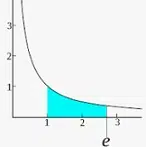Before entering fully into the meaning of the term natural logarithm that concerns us now, we are going to proceed to discover the etymological origin of the two words that give it shape:
-Logarithm, first of all, derives from Greek. A good example of this is that the result of the sum of two lexical components of said language: “logos”, which means “word”, and “arithmós”, which can be translated as “relative number”. This is a term that was first used by the Scottish mathematician John Napier (1550 – 1617). He was the pioneer, therefore, in defining logarithms.
-Natural, secondly, comes from Latin. Exactly it emanates from “naturalis”, which means “relative to nature” and is formed from the union of these lexical components: the adjective “natum”, which is equivalent to “born”; the suffix “-ura”, which is used to indicate the result of the action, and the suffix “-al”, which means “relative to”.
The number to which a positive quantity must be raised so that the result is a certain figure is called a logarithm . The logarithm function, therefore, assigns an exponent (a power) to a number (called an argument ), to which the base (another number) has to be raised to obtain it.
 This means that the base raised to the power must result in the argument. The base 3 logarithm of 81 is 4 , since 81 (the argument) is equal to 3 (the base) raised to the power 4 .
This means that the base raised to the power must result in the argument. The base 3 logarithm of 81 is 4 , since 81 (the argument) is equal to 3 (the base) raised to the power 4 .
Base to power = Argument
3 to the power of 4 = 81
3 x 3 x 3 x 3 = 81
According to their characteristics , there are different types of logarithms. The natural logarithm , also called natural logarithm , is one that has the number e as a base.
As you can see, to understand what a natural logarithm is, it is essential to understand the concept of the number e . This is the name for a mathematical constant that is equivalent to 2.718281828459...
This number e is the base of natural logarithms. It is a transcendent number (that is, not algebraic) and irrational (its decimal expression is neither periodic nor exact).
It can be said, therefore, that the natural logarithm of a number x is the exponent to which the number e must be raised to obtain x as a result. The mathematician Nikolaus Mercator (1620-1687) is noted as the first person who mentioned the idea of natural logarithm in a publication, although at first it was given the formal name of hyperbolic logarithm since its values were corresponding to those of the sector located below the hyperbola.
In addition to everything indicated, we have to explain that the natural logarithm has different applications. However, among the most significant we can highlight the following:
-To calculate what radioactive decay is.
-It is widely used in the field of statistics to transform data. A transformation that may be necessary for different reasons.
-To calculate probability density functions.
-It can be used to work with what is the exponential growth in the so-called biological populations.
